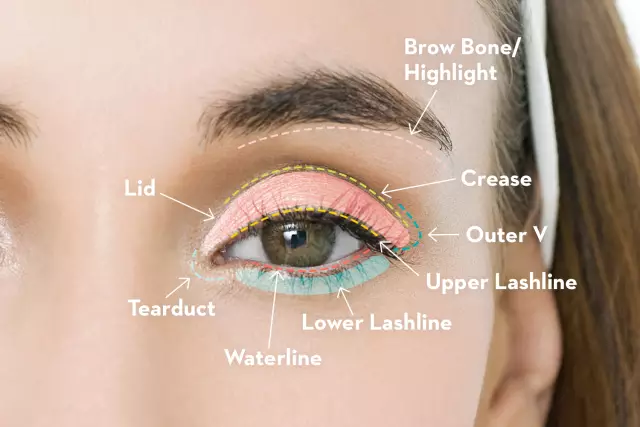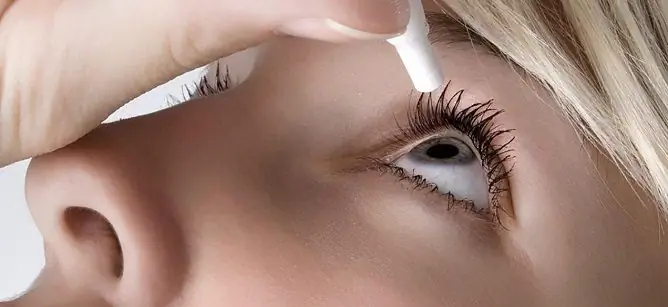- Author Rachel Wainwright [email protected].
- Public 2023-12-15 07:39.
- Last modified 2025-11-02 20:14.
Trilactan
Trilactan: instructions for use and reviews
- 1. Release form and composition
- 2. Pharmacological properties
- 3. Indications for use
- 4. Contraindications
- 5. Method of application and dosage
- 6. Side effects
- 7. Overdose
- 8. Special instructions
- 9. Application during pregnancy and lactation
- 10. Use in childhood
- 11. Use in the elderly
- 12. Drug interactions
- 13. Analogs
- 14. Terms and conditions of storage
- 15. Terms of dispensing from pharmacies
- 16. Reviews
- 17. Price in pharmacies
Latin name: Trilaktan
ATX code: S01EE01
Active ingredient: latanoprost (Latanoprost)
Producer: LLC "GROTEKS" (Russia)
Description and photo update: 2020-25-02
Prices in pharmacies: from 394 rubles.
Buy

Trilactan is an antiglaucoma agent.
Release form and composition
Dosage form - eye drops: clear, colorless liquid (2.5 ml of solution in multi-dose dropper bottles, sealed with a screw cap, or in polyethylene bottles with a dropper, sealed with a lid with a first opening control, in a cardboard box, instructions for using Trilactan and 1 or 3 bottles, complete with or without a stop device).
Composition of the preparation per 1 ml:
- active substance: latanoprost - 0.05 mg;
- auxiliary components: sodium dihydrogen phosphate monohydrate, sodium chloride, sodium hydrogen phosphate anhydrous, benzalkonium chloride, water for injection.
Pharmacological properties
Pharmacodynamics
Latanoprost is an analogue of prostaglandin F2α, a selective agonist of PgF (prostaglandin F) receptors. The drug promotes the outflow of aqueous humor, mainly by the uveoscleral route and through the trabecular network. As a result, intraocular pressure decreases.
The onset of action of the drug is observed 3-4 hours after instillation of Trilactan, the maximum effect develops after 8-12 hours and lasts up to 24 hours.
Latanoprost has no significant effect on the blood-ophthalmic barrier and the production of aqueous humor.
Trilactan used in therapeutic doses does not significantly affect the respiratory and cardiovascular systems.
Pharmacokinetics
Latanoprost is a prodrug esterified with an isopropyl group. It has a molecular weight of 432.58. It is not active, but becomes biologically active after hydrolysis to the acid form.
After instillation into the conjunctival sac, it is well absorbed through the cornea. When it gets into aqueous humor, it completely hydrolyzes, the maximum concentration (C max) is reached here 2 hours after instillation of Trilactan. In studies on monkeys, it was found that the drug is distributed mainly in the conjunctiva, anterior chamber of the eye, eyelids. A small amount of the drug reaches the posterior chamber of the eye.
In the active form, latanoprost is almost not metabolized in the tissues of the eye, however, it is biotransformed in the liver.
The half-life (T 1/2) from plasma is 17 minutes.
In animal studies, it was found that the main metabolites of latanoprost (1,2-dinor- and 1,2,3,4-tetranormetabolites) have extremely low or no biological activity, they are excreted mainly in the urine.
Compared with adults, the exposure of latanoprost is approximately 2 times higher in children 3-12 years old, approximately 6 times higher in children under 3 years old. However, in general, the safety profile and T 1/2 of the drug in children and adults do not differ.
The maximum plasma concentration of latanoprost acid is 5 minutes in patients of all age groups. At equilibrium concentration, latanoprost acid does not accumulate in blood plasma.
Indications for use
Trilactan is intended to reduce intraocular pressure in patients with increased ophthalmotonus and open-angle glaucoma.
Contraindications
Absolute:
- children's age up to 1 year;
- hypersensitivity to any component of Trilactan.
It is not recommended to use the drug in patients with an active form of herpetic keratitis, as well as with recurrent herpetic keratitis, especially associated with the intake of prostaglandin F2 α analogues.
Relative contraindications (Trilactan eye drops should be used with extreme caution):
- inflammatory, neovascular glaucoma;
- the presence of risk factors for the development of macular edema, iritis, uveitis;
- aphakia;
- pseudophakia with rupture of the posterior capsule of the lens;
- a history of herpetic keratitis;
- bronchial asthma;
- the preoperative period before the intervention for cataract.
Trilactan, instructions for use: method and dosage
The Trilactan solution must be instilled 1 drop into the affected eye (s) 1 time per day, preferably in the evening. More frequent use of the drug is impractical, since this reduces the hypotensive effect.
The dosage regimen for children, adults and the elderly is the same.
How to use a bottle with a stop device:
- Remove the bottle and the stop device from the cardboard box.
- Open the bottle with the device.
- Secure the device to the neck of the bottle.
- Place the emphasis on the eyelid so that the dropper is opposite the eyeball.
- Instill the drug.
- Remove the stop device from the neck of the bottle.
- Screw the cap on the bottle.
If the next instillation is missed, you should not double the dose, you must adhere to the usual treatment regimen.
Immediately after instilling Trilactan, it is recommended to press for 1 minute the lower lacrimal opening at the inner corner of the eye on the lower eyelid.
With the simultaneous appointment of two ophthalmic agents between their instillations, at least 5-minute intervals should be maintained.
Side effects
- on the part of the organ of vision *: very often (≥ 1/10) - irritation of the eyes of mild to moderate (tingling, feeling of sand in the eyes, burning sensation, itching, feeling of a foreign body in the eye), changes in eyelashes (amount and pigmentation, thickness and length), conjunctival hyperemia, iris hyperpigmentation; often (≥ 1/100, <1/10) - eye pain, blepharitis, transient punctate erosions on the epithelium (mostly asymptomatic); infrequently (≥ 1/1000, <1/100) - blurred vision, dryness of the mucous membrane of the eye, conjunctivitis, eyelid edema, keratitis; rarely (≥ 1/10 000, <1/1000) - change in the direction of eyelash growth, reactions from the eyelid skin (including darkening), periorbital edema, eyelid edema, macular edema, corneal edema, distichiasis, iritis and uveitis (mainly in predisposed patients), photophobia, corneal erosion; very rare (<1/10 000) - changes in the eyelash and periorbital region, causing a deepening of the groove of the upper eyelid; unknown frequency (it is impossible to estimate the frequency based on the available data) - drug-induced pseudo-pemphigoid of the conjunctiva, iris cyst;
- on the part of the skin: infrequently - rash; rarely - itchy skin; very rarely - local skin reactions on the eyelids (including darkening of the skin);
- from the respiratory system: rarely - shortness of breath, bronchospasm (including exacerbation of bronchial asthma);
- on the part of the cardiovascular system: infrequently - palpitations, angina pectoris; unknown frequency - unstable angina;
- from the nervous system: unknown frequency - dizziness, headache;
- on the part of the musculoskeletal system: unknown frequency - arthralgia, myalgia;
- infections and invasions: unknown frequency - herpetic keratitis;
- others: very rarely - chest pain.
* Adverse reactions from the organ of vision, with the exception of pigmentation of the iris, mainly occur immediately after instillation and are reversible.
Overdose
In case of an overdose, latanoprost can cause irritation of the mucous membrane of the eyes, hyperemia of the episclera and conjunctiva.
In case of accidental ingestion of the drug, it should be borne in mind that 1 vial (2.5 ml of solution) contains 125 μg of latanoprost. At least 90% of Trilactan is metabolized during the first passage through the liver. After an intravenous dose of 3 μg / kg, no disturbances occurred in healthy volunteers. However, the infusion of a dose of 5.5-10 mcg / kg caused nausea, abdominal pain, sweating, hot flashes, fatigue and dizziness.
In bronchial asthma, instillation of latanoprost into the conjunctival sac at a dose that was 7 times higher than the therapeutic dose did not cause the development of bronchospasm.
In case of an overdose of Trilactan, symptomatic treatment is indicated.
special instructions
With long-term use of Trilactan, a gradual and irreversible change in eye color is possible, namely, an increase in the amount of brown pigment in the iris. Patients should be warned about this, especially if it is necessary to treat only one eye, since heterochromia is possible. Change in eye color is more often observed in persons with unevenly colored membranes: gray-brown, green-brown, yellow-brown, brown-blue.
In ongoing studies, darkening usually began in the first 8 months of Trilactan use, rarely within 2-3 years, and was not observed after 4 years. Over time, the progression of iris pigmentation decreased, after 5 years it stabilized. In the course of an open 5-year study of latanoprost, color change developed in 33%, in most cases, pigmentation was insignificant and practically had no clinical manifestations. In patients with uniformly colored blue irises, no pigmentation changes were observed. In persons with uniformly colored brown, gray and green irises, changes were rarely observed.
Darkening of the eyes is due to the fact that under the action of Trilactan in the stromal melanocytes of the iris, the content of melanin (and not the number of melanocytes) increases. Typically, brown pigmentation appears around the pupil and extends to the periphery of the iris. The iris acquires brown color in whole or in parts. No further darkening of the eyes was observed after discontinuation of treatment.
Latanoprost does not affect the lentigines and nevi of the iris, does not accumulate in the sclero-corneal trabecular meshwork and other parts of the anterior chamber of the eye.
Based on the available reports, there were no symptoms and pathological disorders with a change in eye color, therefore, if necessary, Trilactan treatment can be continued. However, it is recommended to carefully monitor the condition of patients.
Trilactan, like most ophthalmic drops, contains benzalkonium chloride as a preservative. This drug in rare cases causes eye irritation, punctate keratopathy, toxic ulcerative keratopathy. With long-term treatment, it is necessary to carefully monitor the condition of patients with corneal diseases and dry eye syndrome. Also, the substance is absorbed by soft contact lenses and discolors them, so you need to remove the lenses before instilling the eyes and put them on at least 15 minutes.
There is no information about the effect of latanoprost on the course of secondary glaucoma, which forms against the background of neovascular glaucoma and inflammatory eye diseases.
There is only little experience with the use of Trilactan in the treatment of pigmentary, congenital and angle-closure glaucoma, as well as open-angle glaucoma in persons with pseudoaphakia.
Limited data on the use of latanoprost in the postoperative period after cataract extraction, so Trilactan should be used with caution.
Latanoprost does not change the size of the pupil.
It is recommended to avoid the use of the drug in chronic recurrent and acute herpetic keratitis. Trilactan should be used with caution in patients with a history of herpetic keratitis.
There are known cases of the development of macular edema (including cystic) during treatment with latanoprost. The disorder prevailed in patients with risk factors for its development (such as retinal vein occlusion and diabetic retinopathy), pseudophakia, aphakia, rupture of the posterior lens capsule. In these groups of patients, as well as in the presence of risk factors for the development of uveitis and iritis, Trilactan should be used with extreme caution.
Often, against the background of therapy, there is a gradual change in eyelashes and vellus hair: increased pigmentation, a change in the direction of growth of eyelashes, their thickening, lengthening and an increase in density. These changes are reversible and disappear after Trilactan is discontinued.
The experience of treating patients with bronchial asthma with latanoprost is limited, however, in the post-registration study, cases of shortness of breath and / or exacerbation of the disease were noted. In this regard, careful monitoring of the therapy process is required.
Trilactan can cause darkening of the skin of the periorbital area, in some cases it disappears with continued treatment.
Influence on the ability to drive vehicles and complex mechanisms
Immediately after instillation of Trilactan, the clarity of visual perception may be temporarily impaired. It is not recommended to carry out potentially dangerous work and drive a car until visual function is restored.
Application during pregnancy and lactation
The safety of latanoprost during pregnancy has not been established. It is assumed that the drug may have a negative effect on the fetus and the newborn, therefore Trilactan eye drops are prohibited for the treatment of pregnant women.
Latanoprost and its metabolites are excreted in breast milk. If treatment is required during lactation, the woman is advised to stop breastfeeding the baby.
In animal studies, no effect on female or male fertility has been identified.
Pediatric use
There is no data indicating the safety and effectiveness of using drops in children under 1 year old, therefore, the appointment of Trilactan is contraindicated for them.
There is no information on the safety of long-term use of latanoprost in children.
Use in the elderly
Trilactan is used according to indications in the elderly.
Drug interactions
Trilactan is pharmaceutically incompatible with ophthalmic agents containing thiomersal.
With the simultaneous use of another analogue of prostaglandins or its derivative, an excessive increase in intraocular pressure is possible, therefore, the appointment of such a combination is not recommended.
Analogs
Trilactan's analogs are Bimatan, Bimoptik Rompharm, Glaumax, Glauprost, Ksalatan, Xalatamax, Lanotan, Prolatan, Latanomol, Travaksal, Taflopress Romfarm, Travapress, Travoprost-Optic.
Terms and conditions of storage
Store at 2-8 ° С. The opened bottle can be stored at room temperature (up to 25 ° C).
Keep out of the reach of children.
Shelf life - 3 years, after the first opening of the bottle - 1 month.
Terms of dispensing from pharmacies
Dispensed by prescription.
Reviews about Trilactan
There are no reviews directly about Trilactan. However, there are many reports of other drugs that also contain latanoprost as an active substance. Patients respond positively to these medicines, which are good at reducing high intraocular pressure. However, the following undesirable reactions are often caused: discoloration of the eyes, burning sensation, itching and a feeling of the presence of a foreign body in the eye.
Given such a frequent side effect of the drug as lengthening and thickening of eyelashes, many women use products that contain latanoprost exclusively for this purpose, simply by applying the solution with a small brush along the growth of the eyelashes.
The price of Trilactan in pharmacies
The price of Trilactan in the form of 0.005% eye drops is approximately 445 rubles. for 1 dropper bottle with a volume of 2.5 ml.
Trilactan: prices in online pharmacies
|
Drug name Price Pharmacy |
|
Trilactan 0.005% eye drops 2.5 ml 1 pc. 394 r Buy |
|
Trilactan eye drops 0.005% 2.5 ml 461 r Buy |
|
Trilactan eye drops 0.005% vial. 2.5ml 3 pcs. 901 RUB Buy |

Anna Kozlova Medical journalist About the author
Education: Rostov State Medical University, specialty "General Medicine".
Information about the drug is generalized, provided for informational purposes only and does not replace the official instructions. Self-medication is hazardous to health!






